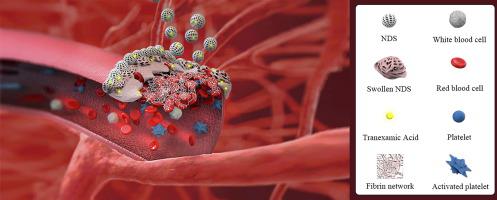Chemical Engineering Journal ( IF 13.3 ) Pub Date : 2021-03-13 , DOI: 10.1016/j.cej.2021.129252 Ahmad Mahmoodzadeh , Jafarsadegh Moghaddas , Seyedhosein Jarolmasjed , Abbas Ebrahimi Kalan , Mahdi Edalati , Roya Salehi

|
Engineering of effective and biocompatible hemostatic materials to control massive bleeding is one of the interesting research fields. Herein, cellulose-based polymer modified by silica aerogel and calcium chloride was used for suitable control of bleeding. Novel developed superabsorbent (NDS) was synthesized by chemical and physical cross-linking methods. NDS not only quickly absorbs a high amount of blood component (60 g/g), but it can also adhere strongly (~90 KPa) to damaged tissue. The contributions of the freeze-drying method and presence of silica aerogel as structural modifiers led to the creation of a superabsorbent with a porosity percentage of 70% which creates a significant ability to absorb blood cells. NDS negative surface charge and presence of silica nanoparticles and calcium ions accelerate activation of the coagulation cascade process. Superior hemostatic ability of NDS compared to commercial hemostatic powder (Gelita-Cel® and Traumastem®) was proved by complementary tests such as blood absorption content, RBC attachment, blood clotting index (BCI), platelet adhesion, clotting time test and partial thromboplastin time (PTT). In vivo study results demonstrate that the NDS could successfully decrease bleeding time and blood loss amount in Wistar rat’s cut-out femoral artery, 2.25 and 4.3 fold better than Gelita-Cel® and 2.13 and 4.4 fold better than Traumastem®. NDS biodegradability was proved by its implantation inside the Wistar rat's body during 14 days. Biochemical, hematological, and pathological tests did not show inflammation and toxic effects in the liver and renal tissues, skin tissues, and alteration in complete blood count parameters (CBC) in NDS treated Wistar rats. In conclusion, the cellulose-based NDS hemostatic biomaterial is suggested for future clinical trial studies due to its powerful ability in bleeding control.
中文翻译:

可生物降解的纤维素基超强吸收剂作为有效的止血剂
设计有效且生物相容的止血材料以控制大量出血是有趣的研究领域之一。在本文中,使用二氧化硅气凝胶和氯化钙改性的纤维素基聚合物用于适当地控制出血。通过化学和物理交联方法合成了新型开发的超吸收剂(NDS)。NDS不仅可以迅速吸收大量的血液成分(60 g / g),而且还可以牢固地(〜90 KPa)粘附在受损的组织上。冷冻干燥法的贡献以及二氧化硅气凝胶作为结构改性剂的存在导致产生了孔隙率百分比为70%的超吸收剂,从而产生了显着的吸收血细胞的能力。NDS的负表面电荷以及二氧化硅纳米颗粒和钙离子的存在会加速凝血级联过程的激活。NDS的止血能力优于市售止血粉(Gelita-Cel®和Traumastem®),其补充测试证明了其吸血量,RBC附着,凝血指数(BCI),血小板粘附,凝血时间测试和部分凝血活酶时间(PTT)。体内研究结果表明,NDS可以成功减少Wistar大鼠切开的股动脉的出血时间和失血量,分别比Gelita-Cel®好2.25和4.3倍,比Traumastem®好2.13和4.4倍。NDS的可生物降解性是通过在14天的时间内将其植入Wistar大鼠体内证明的。生化,血液学,病理测试未显示在NDS处理的Wistar大鼠中,肝脏和肾脏组织,皮肤组织有炎症和毒性作用,以及全血细胞计数参数(CBC)发生变化。总之,基于纤维素的NDS止血生物材料因其强大的止血能力而被建议用于未来的临床试验研究。













































 京公网安备 11010802027423号
京公网安备 11010802027423号